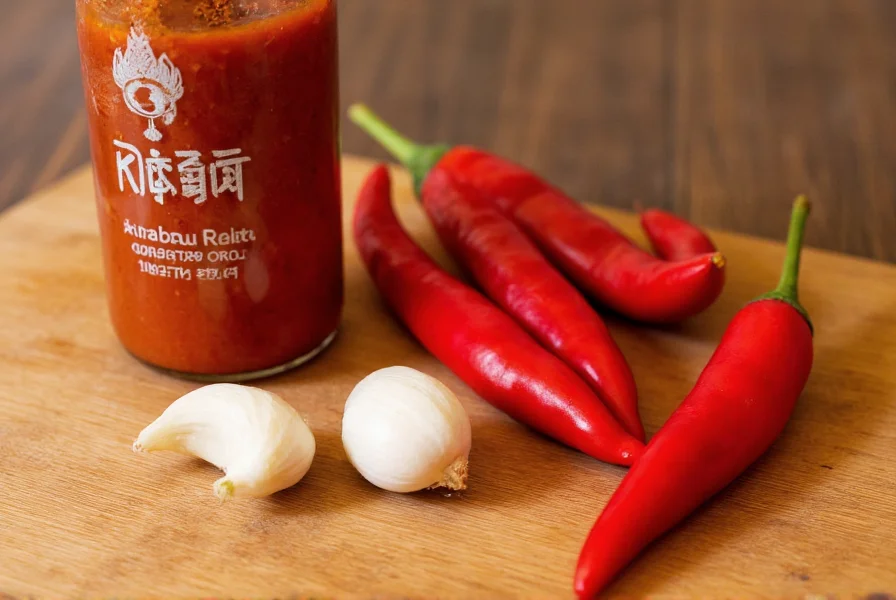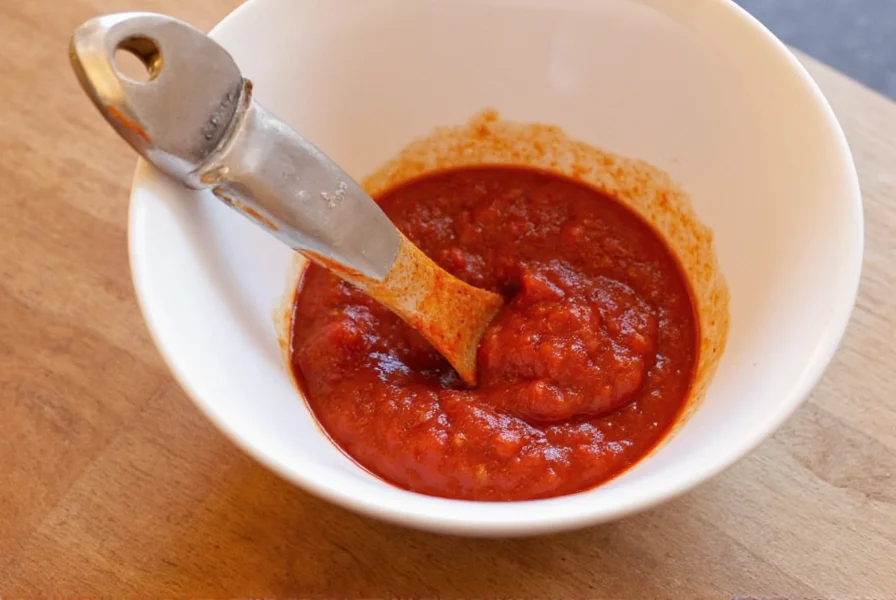The most effective chili paste replacements include sriracha (1:1 ratio), gochujang (1:1 ratio), sambal oelek (1:1 ratio), or a homemade blend of red pepper flakes and tomato paste (1 teaspoon flakes + 1 tablespoon paste). Each substitute offers similar heat and umami but varies in flavor profile, thickness, and additional ingredients like garlic or vinegar. Choose based on your recipe's regional cuisine and desired spice level.
When you're in the middle of cooking and realize you've run out of chili paste, knowing reliable alternatives can save your dish. Chili paste serves as both a heat source and flavor enhancer in many Asian, Latin American, and African cuisines, providing that essential umami depth alongside spiciness. Understanding what makes chili paste unique helps you select the most appropriate substitute for your specific culinary needs.
Understanding Chili Paste Characteristics
Before selecting a replacement, recognize that chili paste isn't just about heat. Traditional chili pastes like sambal oelek, doubanjiang, or nam prik contain:
- Fermented chilies providing complex flavor
- Natural thick consistency that clings to food
- Umami elements from ingredients like garlic, vinegar, or fermented beans
- Regional flavor profiles specific to particular cuisines
When replacing chili paste, consider whether your recipe needs primarily heat, texture, or specific flavor components. This distinction determines which substitute will work best in your dish.
Top 5 Chili Paste Substitutes Ranked by Effectiveness
| Substitute | Ratio | Best For | Adjustments Needed |
|---|---|---|---|
| Sambal oelek | 1:1 | General Asian cooking | None - closest match in texture and heat |
| Sriracha | 1:1 | Thai-inspired dishes | Add 1 tsp cornstarch to thicken if needed |
| Gochujang | 1:1 | Korean recipes | Reduce sugar elsewhere; slightly sweeter |
| Harissa | 1:1 | Middle Eastern/North African dishes | Expect smokier, more complex flavor profile |
| Homemade blend (1 tsp red pepper flakes + 1 tbsp tomato paste + 1 tsp vinegar) | 1:1 | Emergency substitute | Adjust vinegar to taste; less complex flavor |
Detailed Substitute Analysis
Sambal Oelek: The Closest Match
Sambal oelek makes the most straightforward chili paste replacement because it shares nearly identical ingredients and texture. This Indonesian staple consists primarily of ground red chilies, vinegar, and salt without additional sweeteners. When substituting in recipes calling for generic "chili paste," sambal oelek requires no ratio adjustments and delivers comparable heat levels. Professional chefs often keep sambal oelek as their go-to chili paste alternative for Southeast Asian cooking.

Sriracha: The Accessible Alternative
While technically a sauce rather than a paste, sriracha works well as a chili paste substitute in most applications. Its primary differences are added garlic and a thinner consistency. For best results when replacing chili paste with sriracha:
- Use equal amounts for mild recipes
- Reduce by 25% in spicy dishes (sriracha often packs more heat)
- Add 1 teaspoon cornstarch per tablespoon if thickening is crucial
- Compensate for extra garlic by reducing other garlic ingredients
Gochujang: For Korean-Inspired Dishes
Gochujang brings a distinctive sweet, fermented depth that works beautifully as a chili paste replacement in Korean recipes. This thick, reddish paste contains glutinous rice, fermented soybeans, and sugar alongside chilies. When substituting gochujang for standard chili paste:
- Maintain 1:1 ratio for heat level
- Reduce added sugar by 1-2 teaspoons per tablespoon used
- Expect richer, more complex flavor with noticeable sweetness
- Best for bibimbap, tteokbokki, and Korean barbecue marinades
Cuisine-Specific Substitution Guide
Different culinary traditions use distinct chili pastes, so the ideal replacement varies by recipe origin:
| Cuisine Type | Original Paste | Best Substitute | Special Considerations |
|---|---|---|---|
| Thai | Nam prik | Sriracha + fish sauce | Add 1 tsp fish sauce per tbsp sriracha for authentic flavor |
| Chinese | Doubanjiang | Miso paste + red pepper flakes | Use 1 tbsp miso + 1 tsp flakes per tbsp doubanjiang |
| Korean | Gochujang | Sambal oelek + sugar | Add 1 tsp sugar per tbsp sambal for similar sweetness |
| Mexican | Chipotle in adobo | Smoked paprika + tomato paste | Mix 1 tsp paprika + 1 tbsp paste + 1 tsp vinegar |
Adjusting Spice Levels When Substituting
Chili heat varies significantly between substitutes. Use this guide to maintain consistent spiciness:
- Mild dishes: Reduce substitute by 25% compared to original recipe
- Medium heat: Use equal amounts but taste before adding more
- Extra spicy: Increase substitute by 10-15% or add cayenne incrementally
Remember that heat perception develops over time. Add substitutes gradually, allowing 5-10 minutes between additions for flavors to meld. Acidic ingredients like lime juice or vinegar can help balance excessive heat if you overdo it.
Homemade Emergency Substitute Recipe
When you need a quick chili paste replacement without specialty ingredients, this pantry-friendly blend works surprisingly well:
- Mix 1 tablespoon tomato paste with 1 teaspoon red pepper flakes
- Add 1 teaspoon rice vinegar or apple cider vinegar
- Include 1 small minced garlic clove (optional)
- Stir in 1/4 teaspoon sugar to balance acidity
- Add water 1 teaspoon at a time until desired consistency
This combination mimics the texture and basic flavor profile of most chili pastes. For Thai recipes, add 1/2 teaspoon fish sauce; for Korean dishes, include 1/2 teaspoon gochugaru (Korean red pepper flakes) if available.

Storage Tips for Substitutes
Unlike commercial chili pastes with preservatives, many substitutes have shorter shelf lives:
- Sriracha and sambal oelek: Keep refrigerated after opening (6-9 months)
- Gochujang: Refrigerate (up to 1 year)
- Homemade blends: Store in airtight container in refrigerator for up to 2 weeks
- Freeze small portions of substitutes in ice cube trays for longer storage
Always check for signs of spoilage like mold, off smells, or separation that doesn't resolve with stirring. Proper storage ensures your chili paste alternatives maintain quality and safety.
Frequently Asked Questions
Can I use hot sauce instead of chili paste?
Yes, but with important adjustments. Most liquid hot sauces require thickening with cornstarch (1 teaspoon per tablespoon of sauce) and may need additional umami elements like soy sauce or tomato paste. Reduce the amount by 25% compared to what the recipe specifies for chili paste, as liquid hot sauces often deliver more concentrated heat.
What's the difference between chili paste and chili garlic sauce?
Chili garlic sauce contains significant amounts of garlic (typically 20-30% of the ingredients) along with vinegar and sugar, making it more of a finished condiment. Standard chili paste focuses primarily on chilies with minimal additional ingredients. When substituting one for the other, reduce additional garlic in your recipe by half and expect slightly sweeter, more vinegary results with chili garlic sauce.
How do I adjust recipes when substituting gochujang for regular chili paste?
When using gochujang as a chili paste replacement, maintain the same quantity for heat equivalence but reduce added sugar by 1-2 teaspoons per tablespoon of gochujang used. You may also want to increase acidic elements slightly (like vinegar or citrus) to balance gochujang's natural sweetness. Gochujang works best in recipes that benefit from its distinctive fermented, sweet-spicy profile like Korean barbecue marinades or bibimbap sauce.
Can I make a chili paste substitute without tomato products?
Absolutely. For tomato-free alternatives, try blending roasted red peppers with chilies (1:1 ratio), using miso paste with red pepper flakes (1 tbsp miso + 1 tsp flakes per tbsp paste), or creating a nut-based paste with almonds or cashews blended with chilies and vinegar. These options work particularly well for Middle Eastern or Indian dishes where tomato might clash with other flavors.
Why does my substitute make my dish too watery?
Many chili paste substitutes like sriracha or harissa have higher liquid content than traditional thick pastes. To prevent watery results, either reduce other liquids in the recipe by 1-2 tablespoons, simmer the dish longer to evaporate excess moisture, or thicken the substitute itself by mixing with 1 teaspoon cornstarch per tablespoon before adding to your recipe. For best results, add substitutes toward the end of cooking rather than at the beginning.











 浙公网安备
33010002000092号
浙公网安备
33010002000092号 浙B2-20120091-4
浙B2-20120091-4